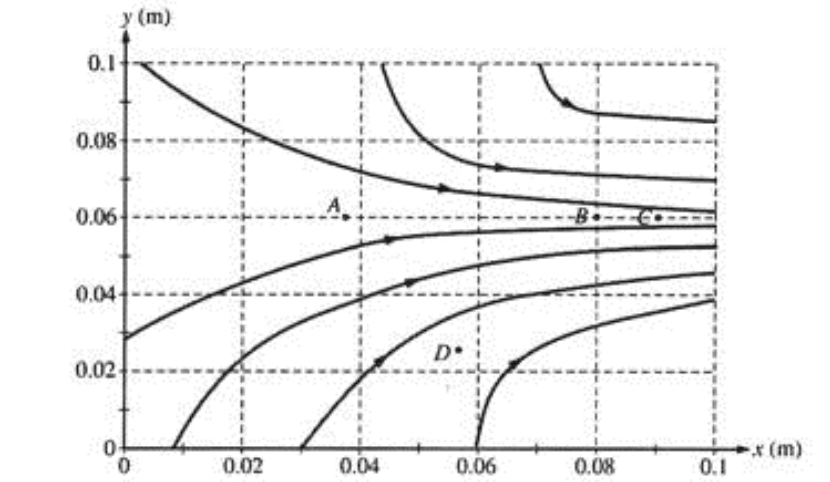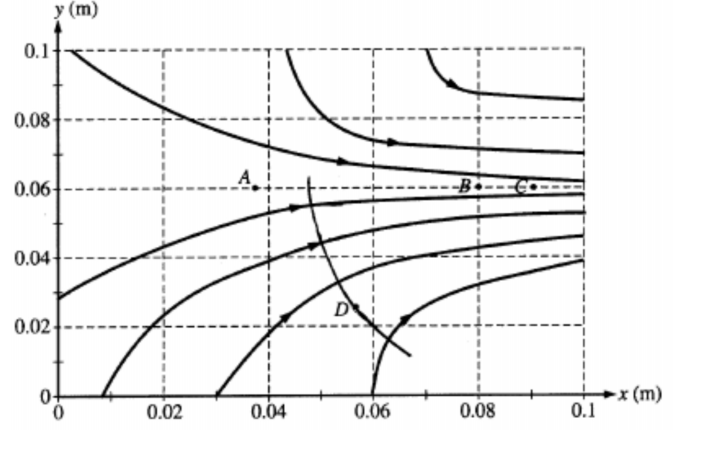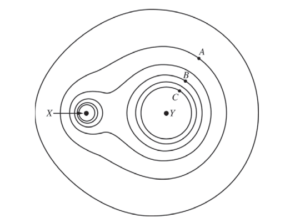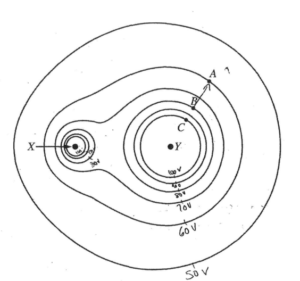Question

Consider the electric field diagram above.
a. Points A, B, and C are all located at y = 0.06 m .
i. At which of these three points is the magnitude of the electric field the greatest? Justify your answer.
ii. At which of these three points is the electric potential the greatest? Justify your answer.
b. An electron is released from rest at point B.
i. Qualitatively describe the electron’s motion in terms of direction, speed, and acceleration.
ii. Calculate the electron’s speed after it has moved through a potential difference of 10 V.
c. Points B and C are separated by a potential difference of 20 V. Estimate the magnitude of the electric field midway between them and state any assumptions that you make.
d. On the diagram, draw an equipotential line that passes through point D and intersects at least three electric field lines.
▶️Answer/Explanation
Ans:
a. i. The magnitude of the field is greatest at point C because this is where the field lines are closest together.
ii. The potential is greatest at point A. Electric field lines point from high to low potential.
b. i. The electron moves to the left, against the field lines. As the field gets weaker the electron’s acceleration to the left decreases in magnitude, all the while gaining speed to the left.
ii. W = qΔV = ½ mv2 gives v = 1.9 × 106 m/s
c. If we assume the field is nearly uniform between B and C we can use E = ΔV/d where the distance between B and C d = 0.01 m giving E = 20 V/0.01 m = 2000 V/m
d. 
Question: (12 points, suggested time 25 minutes)

The dots in the figure above represent two identical spheres, X and Y, that are fixed in place with their centers in the plane of the page. Both spheres are charged, and the charge on sphere Y is positive. The lines are isolines of electric potential, also in the plane of the page, with a potential difference of 10 V between each set of adjacent lines. The absolute value of the electric potential of the outermost line is 50 V.
(a) Indicate the values of the potentials, including the signs, at the labeled points A and B.
Potential at point A _______________ Potential at point B _________________
(b)
i. How do the magnitudes and the signs of the charges of the spheres compare? Explain your answer in terms of the isolines of electric potential shown.
ii. The spheres at points X and Y have masses in the same ratio as the magnitudes of their charges. The isolines of gravitational potential for the spheres have shapes similar to those of the isolines shown.
Explain why the two sets of isolines have similar shapes.
Let the potentials at the three labeled points be VA , VB , and VC . A proton with charge +q and mass m is released from rest at point B.
(c) Based on your answer to part (b)(ii), briefly describe one similarity and one difference between the electric and gravitational forces exerted on the proton by the system of the two spheres. The similarity and difference you describe must not be ones that generally apply to all forces.
(d) At some time after being released from rest at point B, the proton has moved through a potential difference of magnitude 20 V.
i. Determine the change in electric potential energy of the proton-spheres system when the proton has moved through the 20 V potential difference. Express your answer symbolically in terms of q, VA , VB , VC , and physical constants, as appropriate.
ii. As it moved through the 20 V potential difference, the proton was displaced a distance d by the electric force. Determine a symbolic expression for the total work done on the proton by the electric field in terms of the average magnitude Eavg of the electric field over that distance.
iii. Two students are discussing how and why the kinetic energy of the proton would change after it is released.
• Student 1 says that if the system is defined as the proton and the spheres, the increase in the proton’s kinetic energy is due to a change in the system’s potential energy as the proton moves through the 20 V potential difference.
• Student 2 says that if the system is defined as only the proton, the kinetic energy of the proton increases because positive work is done on the proton by the electric field as the proton moves through the 20 V potential difference.
Discuss each student’s claims, explaining why each is correct or incorrect.
▶️Answer/Explanation
Ans:

(a) Indicate the values of the potentials, including the signs, at the labeled points A and B.
Potential at point A ___60 V________ Potential at point B _____80 V_______
(b) i.
As the isolines of equivalent potentials are further from Y than X, Y must have a greater charge. As the lines envelope both spheres, and next uniformly parallel directly between the two sphere, they must have the same sign.
ii.
Gravitational and electric potential both vary inversely will distance from the source, and, as both charges are the same sign and gravity can only go one direction, the potentials from both spheres will combine similarly.
(c)
One difference is that gravity would cause the proton to move toward spheres, but, any the proton and spheres have the same sign, the electric force would repel the proton away from spheres.
The similarly between both forces is that both magnitudes would vary proportionally to the inverse square of the proton’s distance from spheres.
(d) i.
ΔUE = q ΔV
VA=VO = -20V Proton moves away from point Y, (B to A)
ΔUE = q (VA-VB)
ii.
W = Favg . d Favg = Eavg . q
= Eavg.g.d
iii.
Student 1 is correct, as some of the electrical potential energy of the proton in the proton-sphere system is lost as it moves through the 20V potential difference, and converted into kinetic energy via the electric field doing work on the proton.
Student 2 is also correct, because alone the proton goings kinetic energy from moving through the 20 V potential difference due to the electric force acting on the proton over a given distance.
